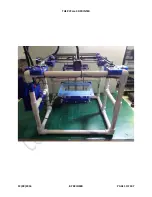
page
61
of
62
3DGence DOUBLE P255 | version 09.2018
HIPS (High-Impact Polystyrene)
–
styrene polymer. It is used in 3D printing mainly as a material for printing support structures
when printing with ABS. Soluble in D-limonene. Characterized by high impact resistance and low elasticity.
Normal
–
common name of the normal vector to a surface, used in 3D modelling. Normal vector is a vector perpendicular to
the plane, or in the case of other surfaces perpendicular to the plane tangent to the surface at a given point. In 3D modelling,
its sense defines the inside and the outside of the model. In most cases, it is assumed that the normal is correctly directed to
the outside of the model.
Nylon
–
group of polyamides developed by DuPont. Currently, it is also used for manufacturing durable filaments for 3D
printing. The main advantages of such printouts are: high mechanical and chemical resistance, the possibility of processing and
dyeing with fabric dyes. The printouts are also characterized by some flexibility and tear resistance.
OBJ
–
popular format of 3D files. It may contain an additional MTL file (Material Template Library), which is irrelevant to FFF
printing, containing information on material libraries defined for the model. Apart from the geometry definition, arrangement
of vertices and the sense of the normals, the OBJ files contain the information on UV coordinates for textures. It is read by
3DGence Slicer program.
PLA
(polylactide
–
polylactic acid)
–
produced in industrial quantities by ecological methods. The main sources of the raw
materials for its production are cereals, e.g. corn starch or bacterial cultures. This is the basic material for FFF 3D printing.
Thanks to its low cost, lack of thermal shrinkage, good adhesion to the heatbed and a multitude of filling variants and colours,
PLA is the most universal and the most commonly used filament. During printing, it emits a weak, neutral smell, does not emit
harmful substances and is fully biodegradable. Because it is more brittle and vulnerable to mechanical damage than ABS, its
use for the production of functional prototypes of mechanical devices is limited.
Overhang
–
characteristic shape in a model printed during FFF 3D printing. This shape occurs where the model plane forms an
overhang over the heatbed or another part of model. 3DGence Slicer software recognizes these surfaces and analyses the angle
of overhang relative to the heatbed. If the angle exceeds the boundary angle defined in the software, 3DGence Slicer will
automatically generate support structures under such a surface.
PVA
(polivinyl alcohol)
–
a water-soluble synthetic polymer. It is used from making water-soluble filaments that are perfectly
suitable for printing the support structures in dual-material printing. The model itself is printed using insoluble material (most
frequently PLA) and can be thoroughly cleaned in water bath. The use of an ultrasonic cleaner significantly accelerates this
process.
Raft
–
one of the methods of increasing the adhesion of printout to heatbed. Raft is a base (platform) consisting of several
alternately laid layers, which is generated by the slicer under the model. Raft is larger than the outline of the model, which
increases the adhesion of the printout to the heatbed and also prevents the effects of thermal shrinkage (plastic-plastic
connection). Another advantage of the raft is that it levels small irregularities of the heatbed surface. Raft also makes it easier
to print models that do not have a flat surface that would serve as the base.
Stepper motor
–
brushless electric motor that can rotate at precisely defined step angles. This is possible thanks to the
arrangement of pairs of electromagnets A and B around a gear-shaped iron rotor connected to the motor shaft. Due to the fact
that they ensure very precise position control, the stepper motors are the main drive of 3DGence DOUBLE P255 printer.
Skirt
–
additional material extruded at the very beginning of printing at a distance of several millimetres around the model that
is being printed. Skirt is not an integral part of model. The purpose of this function is to initiate and stabilise the flow of plastic
through the hotend. Observing how the printer lays the skirt on the heatbed, we can also assess whether the heatbed is
properly levelled and the printout will adhere properly to it.
Содержание DOUBLE P255
Страница 1: ...USER S MANUAL 3DGence DOUBLE P255...
Страница 27: ...page 27 of 62 3DGence DOUBLE P255 version 09 2018 Fig 33 Main menu structure in the idle mode...
Страница 28: ...page 28 of 62 3DGence DOUBLE P255 version 09 2018 Fig 34 Advanced menu structure...
Страница 29: ...page 29 of 62 3DGence DOUBLE P255 version 09 2018 Fig 35 Main menu structure in the working mode...


































